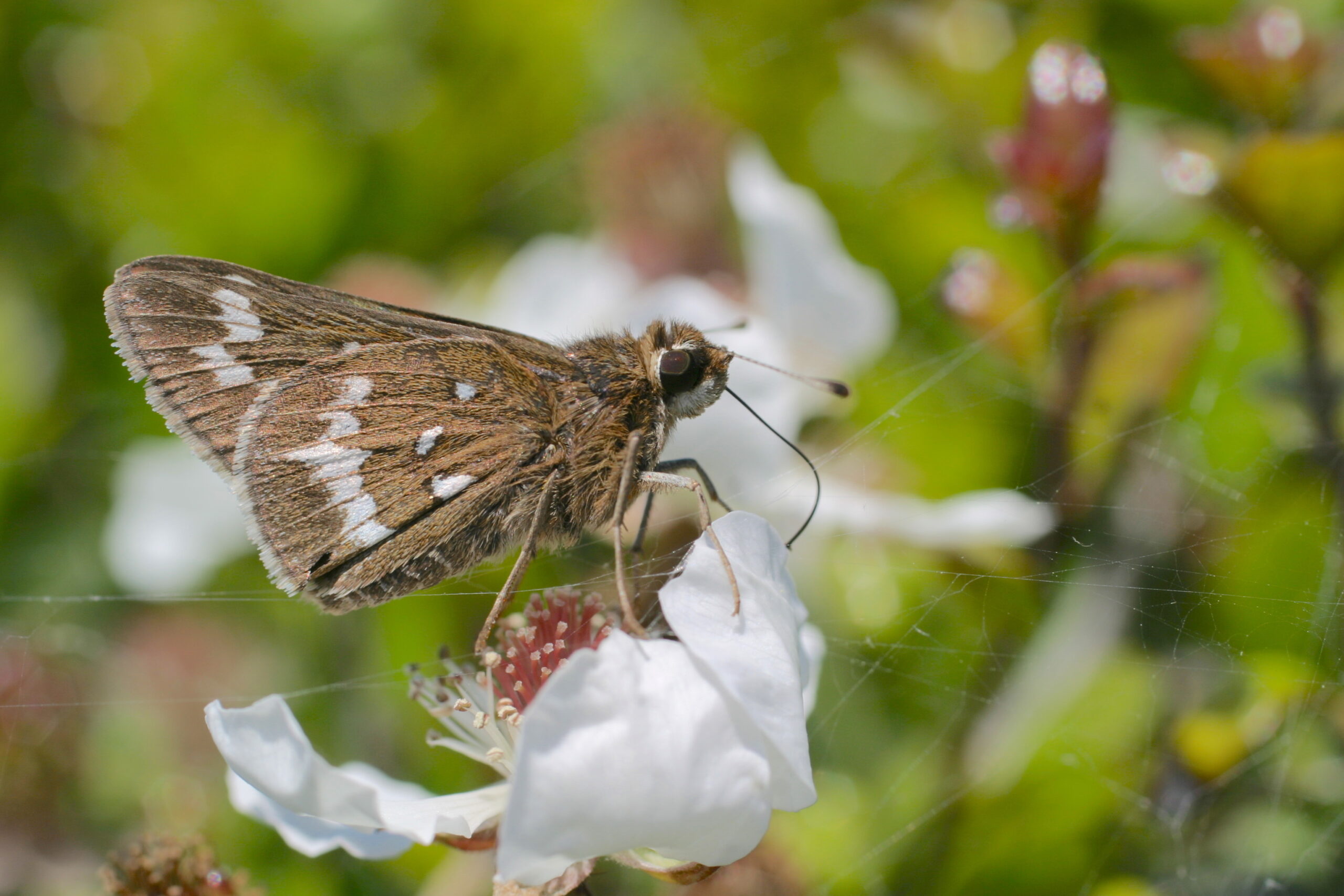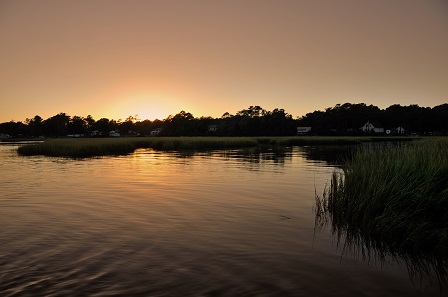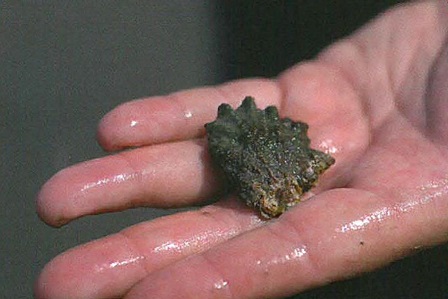NATURALIST’S NOTEBOOK: Bogue’s New Butterfly

The strategic location of Fort Macon on the eastern end of Bogue Banks may have protected Confederate troops from the Union during the civil war, but today its status as a state park protects what may be a new species of butterfly.
Nicknamed the “crystal skipper” by researchers because of its unique association with North Carolina’s Crystal Coast and the crystal-shaped white spots on its wings, this tiny brown butterfly is interesting in itself. But it also may help scientists better understand how landscapes fragmented by development affect the population structure and movement of organisms.
“This butterfly displays an interesting kind of rarity,” says Allison Leidner, a North Carolina Sea Grant researcher and ecology doctoral student at North Carolina State University. “Globally, it’s very restricted — right now we only find it in a 30-mile by 300-foot stretch of barrier island in North Carolina — but locally it’s very abundant.”
The crystal skipper may be a subspecies of a rare butterfly found in the Southeast, but Leidner argues the Bogue butterfly is unique regardless of its scientific classification.
‘The species we think this butterfly might be related to occur in different places and use different kinds of habitats,” she says.
Crystal skippers are tightly associated with seaside little bluestem, a “host” plant that grows on sand dunes. Female butterflies lay their eggs on the plant, and growing larvae eat it, Leidner explains.
Seaside little bluestem has a patchy range along the eastern seaboard, from its southernmost point in North Carolina all the way up to Massachusetts.
But only Bogue Banks has crystal skipper populations.
During the last two years, researchers have identified nine populations, totaling thousands of individuals. While these populations may be thriving, it would take only one natural disaster to wipe them all out, warns Stephen Hall, an invertebrate zoologist with the North Carolina Natural Heritage Program.
“Any time you’ve got your eggs in one tiny basket — especially a basket subject to hurricanes and beachfront development — it’s very precarious.”
TWINS? OR CLOSE COUSINS?
Officially known as “Atyonopsis new species 1,” Bogue’s “butterfly” is actually a “skipper” — a group of insects in the Order Lepidoptera that falls somewhere between the true butterflies, with their flashy splashes of color, and the more mousy-looking moths.
In 1982, Eric Quinter of the American Museum of Natural History stumbled upon the crystal skipper in Fort Macon State Park. Quinter passed his findings on to John M. Burns, a research entomologist with the Smithsonian Institution, who quickly realized the insect was a rare, and possibly new, find.
“It probably is closely related to a butterfly found in peninsular Florida — the Atryonopsis hianna loammi — that is, unfortunately, almost extinct,” Burns says.
Despite years of research, Burns hesitates to classify the crystal skipper as a new species until he can conduct molecular research on the Florida butterfly. He tried using loammi specimens from the 1920s, but the materials were too old for biochemical testing. And finding fresh specimens among an increasingly urbanized Florida landscape proves nearly impossible.
“It [loammi] does exist — I’ve seen pictures of it — but it’s awfully hard to find,” Burns says.
Rather than waiting for an official classification, Hall began documenting the crystal skipper’s natural history in the hopes of placing it on the Federal Endangered Species list eventually.
In the late 1990s, Hall surveyed the entire North Carolina coast and documented the crystal skipper’s association with seaside little bluestem. He only found crystal skipper populations from Bear Island, part of Hammocks Beach State Park, eastward to Fort Macon State Park and Radio Island, near Morehead City and Beaufort.
After learning about Hall’s research on the crystal skipper, Leidner and her advisor, Nick Haddad of NC State, decided the case provided a perfect microcosm to examine the effects of habitat fragmentation on population structure and organism movement.
“Understanding how different features in a landscape — like having really small, empty lots in between places or a protective primary and secondary dune line — might really help this butterfly,” Leidner says.
HABITAT HOPSCOTCH
Armed with a butterfly net, a pair of forceps, and a Sharpie® marker, Leidner spent the last two summers trying to determine population sizes of the crystal skipper and tracking its movements between habitat patches.
Much of her field work occurred during the skippers’ two “flight seasons,” or when the butterflies emerge as adults to mate and lay eggs.
The crystal skipper’s lifecycle — egg, larvae, pupae and adult — takes place in one small area, as opposed to the famously colorful monarchs or sulphurs that migrate through North Carolina each fall. Flight seasons for the crystal skipper are from mid-April to mid-May, and mid-July to mid-August.
In the summer of 2005, Leidner chose Fort Macon State Park to conduct a population study because the area was large enough to facilitate butterfly movement but small enough for one or two people to monitor. Each day, she and an occasional volunteer caught skippers with nets, carefully spread their wings with forceps and numbered them with a Sharpie®.
“It’s a pretty low-tech operation,” she says. “If you recapture them, you use a ratio of the number marked versus the number captured to help establish population size.”
Leidner estimates the population size to be in the thousands.
“What’s also amazing is that the movement recorded is very local,” she says.
Sometimes individuals moved across the entire length of the park, about a mile. A few may have moved further, she adds, but the tracking methods did not extend that far.
“The question I have now is how do they move between different places?” In otherwords, what environmental factors influence them to “choose” one place over another?
DISCOVERY THROUGH DNA
Rather than try to track the movements of all the populations across Bogue Banks, Leidner and her colleagues are looking to genetics for answers.
“By looking at their DNA, we can see how closely they’re related and make an inference as to movement rates between populations,” she explains. “Butterflies that have greater similarities between two different places probably have more movement compared to other places.”
One could assume that butterflies living five miles apart would have more similarities than those living 10 miles apart. But sometimes there are features of the landscape — such as a residential subdivision versus an overgrown, vacant lot — that may promote or discourage movement between populations.
Leidner started collecting butterflies for genetic analyses in the summer of 2006. She already knew that population sizes in certain areas were large, so “we felt comfortable that the numbers we were taking weren’t going to affect the overall population.”
Smaller populations posed more of a problem. She collected both in the spring and the summer flight seasons to spread out the impact, and tried to only take older individuals with less reproductive potential. “Old” is a relative term in this case, Leidner explains. The crystal skipper’s lifespan is typically a matter of days, two weeks maximum. But butterflies with age on them are easy to spot.
“Older individuals are more beat up — they are raggedy, parts of their wings are missing and their scales are worn off.”
Leidner is still analyzing her results from 2006, but she has secured funding to continue studying the crystal skipper and its movements forthe next two summers. Often, she is stopped by curious passersby who either chastise her for treading on the dunes (despite special permits to do so), or ask why she’s wearing long pants in the middle of July.
“Most people are surprised to leam about the crystal skipper when I tell them,” she says. “Here’s this rare butterfly that most people in the world have never seen, and it’s just along the roadside.”
SAVING THE SKIPPER
If the crystal skipper is officially identified as a new or sub-species, Hall believes the work being done will establish it as one of the nation’s rarest insects. But even with a positive identification, getting the butterfly on the endangered species list will be a challenge.
Politically, listing a species is a sensitive issue, especially in areas with rapid development, like Bogue Banks. Listing a species as “endangered” or “threatened” has legal ramifications that can stymie development and prompt changes in zoning laws.
Besides, says Hall: “It’s easier for people to support the conservation of polar bears than odd looking insects.”
Burns is just grateful that Bogue Banks can still sustain populations of the crystal skipper, unlike Florida and the loammi species.
“It’s a good thing Fort Macon State Park exists for this butterfly, because Bogue Banks is pretty built up,” he says. Like Hall, Bums worries about these precious populations surviving the worst.
“If something like Katrina happened there, I’m afraid it might be curtains.”
This article was published in the Spring 2007 issue of Coastwatch.
For contact information and reprint requests, visit ncseagrant.ncsu.edu/coastwatch/contact/.
- Categories:


